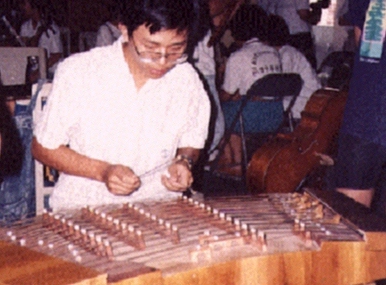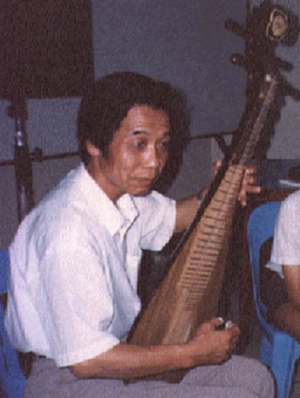 Yang
Qin (pronounced young-chin), a Turkish
Dulcimer.
Yang
Qin (pronounced young-chin), a Turkish
Dulcimer. Plucked-strings
Plucked-strings
consists of the dulcimer, the lute and the harp. Besides the lute, which
has four strings, the dulcimer and the harp has numerous strings. Initially,
these instruments are made of wood or bamboo with silk strings. However,
as years passes, the silk strings are substituted with steel strings which
gives the instruments a richer tone quality. Therefore, the plucked-strings
ensemble is sometimes referred to as the 'silk and bamboo ensemble'.
 Yang
Qin (pronounced young-chin), a Turkish
Dulcimer.
Yang
Qin (pronounced young-chin), a Turkish
Dulcimer.
The instrument is played using two little bamboo hammers, the size of chopsticks, one held in each hand. The notes are played by striking the bamboo hammers on the strings stretched across the frets.
The Yang Qin sounds more or less like the piano. It has
the widest range of scale amongst the plucked-strings instruments (about
5 octaves).
 Pi
Pa, a mongolian lute.
Pi
Pa, a mongolian lute.
The Pi Pa is a pear-shaped lute, played by using imitation fingers. The use of imitation allows more freedom for the player to perform various techniques on the four strings of the lute. The Pi Pa is different from other types of lutes as there are two different types of frets on the instrument. There are 23 bamboo frets and 6 special frets called Xiang (pronounced see-young). The Xiang are made of either wood, jade, horns, or elephant tusks.
The Pi Pa is one of the leading
instruments in the chinese orchestra. The range of techniques that can
be performed on the Pi Pa is the widest among all the plucked-strings and
thus can be said the most expressive instrument in the plucked-string section.
 Gu
Zheng (pronounced koo-cheng),
the chinese harp.
Gu
Zheng (pronounced koo-cheng),
the chinese harp.
The Gu Zheng is an ancient chinese instrument. This harp rests on two pedestal and is played using 3 to 4 imitation nails. There are about 24 to 30 strings stretched across the harp. The strings rest on bamboo frets which are adjustable.
The Gu Zheng is a distinguished
solo instrument and is seldom used in the orchestra. Its attraction lies
on the water-rippling sound produced when the strings are plucked by the
fingers in a sweeping manner from the highest note to the lowest note or
vice versa.
Liu Qin
(pronounced lew-chin), a willow-leaf shaped lute.
The shape of Liu Qin is similar to the Pi Pa except that it is half the
size of Pi Pa. The pitch of the Liu Qin is the highest in the plucked-strings
section and it sometimes functions as the 1st violins.
Ruan,
a round-shaped chinese lute.
The Ruan functions like the cello in the orchestra. The finger board of
Ruan is similar to the Liu Qin and thus there is not much difference in
the techniques. The sound of the Ruan is gentle and soft. Less agility
can be demonstrated in playing of this lute due to the size of the soundbox
and the thickness of the strings.